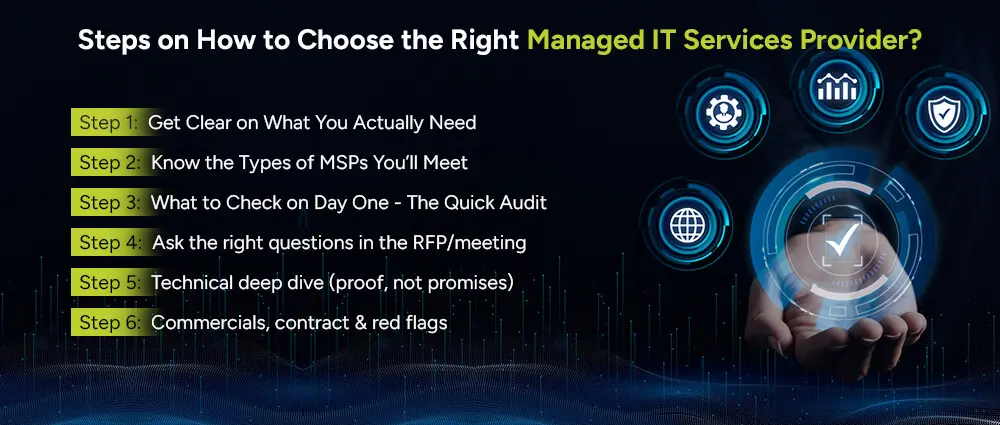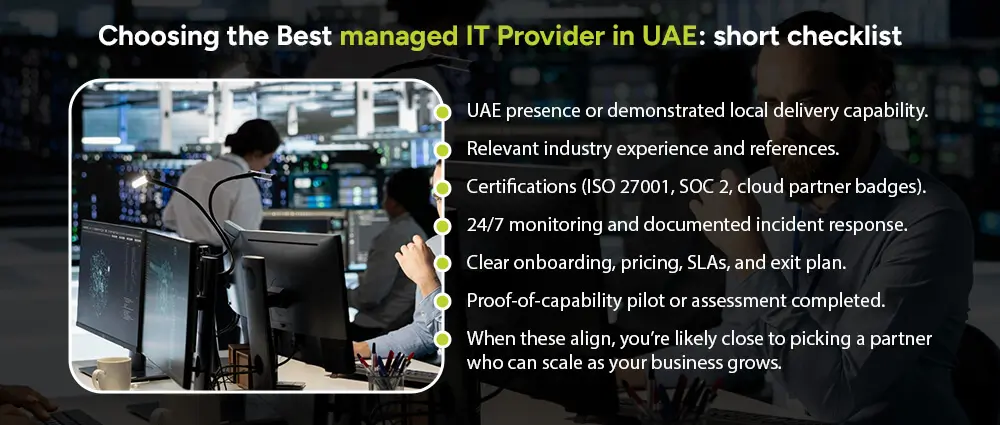Picking a managed IT services partner is one of those business decisions that feels small until everything depends on it: networks, data, payroll, customer trust. If you’re reading this from the UAE, you’re in a market with rapid cloud and data-center growth, rising cyber threats, and a lot of options.
Today, this guide will walk you through exactly how to choose the right Managed IT services provider in plain language, with practical checks, questions, and by pointing out red flags, as well as the facts you should expect to see from reputable local and global sources.
Before we explore the steps, a few quick facts to set the scene:
The UAE’s cloud computing market has grown fast; recent industry reports put its value in the billions (USD 12–13B range around 2024–25), with strong multi-year growth expected to be projected to USD 45.41B by the year 2030.
The managed services market across the Middle East is large and expanding, the region’s managed services market was estimated at USD 22.6 billion in 2024 with a double-digit CAGR projected to go above USD 79B by 2033. That growth drives local MSP availability and competition.
Cyber threats are rising in the UAE and the region (malware detections and targeted attacks have increased), which means security-first MSPs are more vital than ever.
The trends mentioned above mean companies in the UAE are moving core workloads to the cloud, hiring MSPs for security and operations, and expecting strong SLAs and local compliance support.

Don’t start by looking at vendors. Start with your own house:
Answering these clarifies whether you need a broad managed IT provider or a specialized MSP (security, cloud-native, DevOps, software development). Use these answers to create short, prioritized requirements you can send to vendors.
Not all managed service providers are the same. In the UAE you’ll commonly find:
Knowing the category helps you compare “apples to apples” when you ask “How To Pick The Right MSP.”
When evaluating vendors, ask for and verify? Tthese items:
Do they operate in the UAE (office or local engineers)? Can they guarantee data residency if needed? Local presence often means faster on-site response and better understanding of UAE regulatory requirements. (Hyperscaler regions and UAE data centers are expanding across Abu Dhabi and Dubai.)
ISO 27001, ISO 9001, SOC 2, and data protection accreditations. For regulated industries, proof of compliance is non-negotiable.
Do they offer 24/7 monitoring, SIEM/SOAR, managed detection and response (MDR), and incident response playbooks? Given the region’s rising cyber incidents, strong security and cybersecurity services are essential.
Response and resolution times, uptime guarantees, penalties for missed SLAs, and clear escalation paths.
Real UAE clients in your industry, whether it’s medical IT or Retail MSP, complete with contactable references. Ask for metrics: uptime achieved, recovery time objectives (RTO), cost savings.
Fixed monthly, per-user, per-device, or hybrid? Make sure you can forecast costs as you scale.
Clear migration plan, timelines, and an exit clause that guarantees data return in standard formats.
Do they have certified cloud architects, security analysts, and local engineers? Ask to see CVs or bios (non-confidential).
Are they partners with Azure/AWS/Google, or with local data centers? Partnership tiers (e.g., Microsoft Gold) often reflect capability.
When you move to conversations, these practical questions separate vendors who talk from vendors who deliver:
If answers are vague or the vendor avoids concrete numbers, treat that as a red flag.
After shortlisting, ask for a proof of capability:
Many MSPs claim “we’ll secure you,” but real value shows in measurable controls and clear outcomes.
Commercials are where partnerships succeed or sour:
Avoid overly long lock-ins without performance milestones. A 3-year contract should have performance reviews and exit options.
Request clear change-control and pricing for out-of-scope work.
Cost is important, but lowest price rarely equals best value. Consider:
TCO over 3 years, not monthly headline price. Factor in downtime risk, security, and vendor responsiveness.
24/7 SOC access, proactive patching, and backups are worth paying for. Global cybersecurity spend is rising (and for good reason): organizations are investing heavily in security services as threats increase.
If two MSPs offer similar services, prioritize the one with better customer reviews, clearer SLAs, and stronger security capabilities.
When you narrow to your top 2–3 candidates, make sure each vendor ticks these boxes:

The UAE’s digital ecosystem is maturing: cloud services, AI spending, and data-center investments are expanding. Expect:
Pick an MSP that invests in these capabilities or partners with specialists.
A mid-sized UAE retailer engaged an MSP after suffering two weekend outages and a near-miss ransomware event. The MSP’s pilot included 24/7 monitoring, patch automation, and a tested backup/restore plan. Within three months the retailer saw:
These are the sorts of measurable wins you should demand when deciding “How To Pick The Right MSP.”
Choosing the best managed IT Provider in the UAE or looking for a remote MSP team doesn’t need to be a mystery. Start with requirements, test with pilots, insist on transparency, and prioritize security and local delivery. The right MSP support becomes a growth enabler: not just a reactive support vendor.
If you want, we at Arpatech can:
Which would you like first? Our Managed IT Service support specialists are always ready to take your call and answer each question kindly.
Evaluate MSPs against a simple framework: People, Process, Platform, Proof, Price.
Run a short pilot (30–90 days) that simulates real operations: this is the single best test.
Use a weighted scoring model:
Create a list of 8–10 must-have criteria (SLA, security services, local presence, certifications, references, pricing transparency, onboarding plan, exit terms).
The vendor with the highest score is the logical pick, but also include an “empathy check”: did they communicate clearly? Are they responsive during the selection process? Cultural fit and trust are often the tiebreakers.